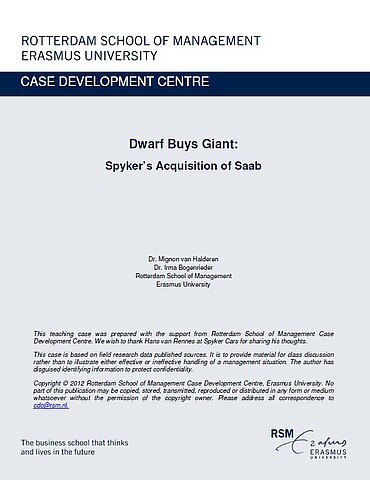Citation Note
Based on Field research; 30 pages.
Follow the 'handle' link to access the Case Study on RePub.
For EUR staff members: the Teaching Note is available on request, you can contact us at rsm.nl/cdc/contact/
For external users: follow the link to purchase the Case Study and the Teaching Note.
Objective
The case serves three objectives. First, it helps students understand the business circumstances in which a small (non-profitable) company can buy a large company that is suffering financially. By analyzing the case, students can gain insights into strategies used to create profitability for both brands. Second, the case helps students understand the implications of an alliance between an exotic, luxury car brand and an upper class, mainstream car brand. Students may ask: • How do you create fit between both brands? • Which branding architectures are most appropriate in this situation? • How do you revitalize a nearly dead brand like Saab? Third, the case helps students understand the role of corporate communications (and corporate stories in particular) in increasing brand credibility (and thus reduce skepticism among stakeholders) after an unconventional acquisition like the Saab-Spyker deal.
description
When the unprofitable Dutch boutique sports carmaker, Spyker, acquired Saab in 2010, scepticism arose about the likely success of this acquisition. Spyker had to convince the public that it could create a solid fit of these two drastically different brands.
Abstract
The Dutch boutique sports carmaker, Spyker, acquired the Swedish carmaker Saab from General Motors (GM) in February 2010. Owing to fading fortunes across its entire business during the recent economic crisis, GM had looked to divest Saab since 2008 and eventually sold it to Spyker at a price much lower than Saab’s real worth. Although Spyker received thousands of Saab fans’ support, others doubted whether Spyker could turn Saab into a viable business. The scepticism was centered on the two companies’ huge differences in sizes and the fact that neither was profitable at the time. Spyker CEO Muller was nevertheless confident he could make Saab profitable by 2012 and restore its once iconic status, which GM had let sink. He thought it crucial to explain the logic behind his decision to those stakeholders who did not believe in the Saab-Spyker synergy. Restoring customer, dealer, investor, employee, and public confidence was his top priority in 2010.
usage
The case gives an insight into unusual acquisitions, such as a small firm buying a larger firm. It also stimulates hindsight discussion – knowing now that Saab has gone bankrupt, was it a good decision to buy Saab after all? The case was a finalist at the Decision Sciences Best Teaching Case Competition 2011.
